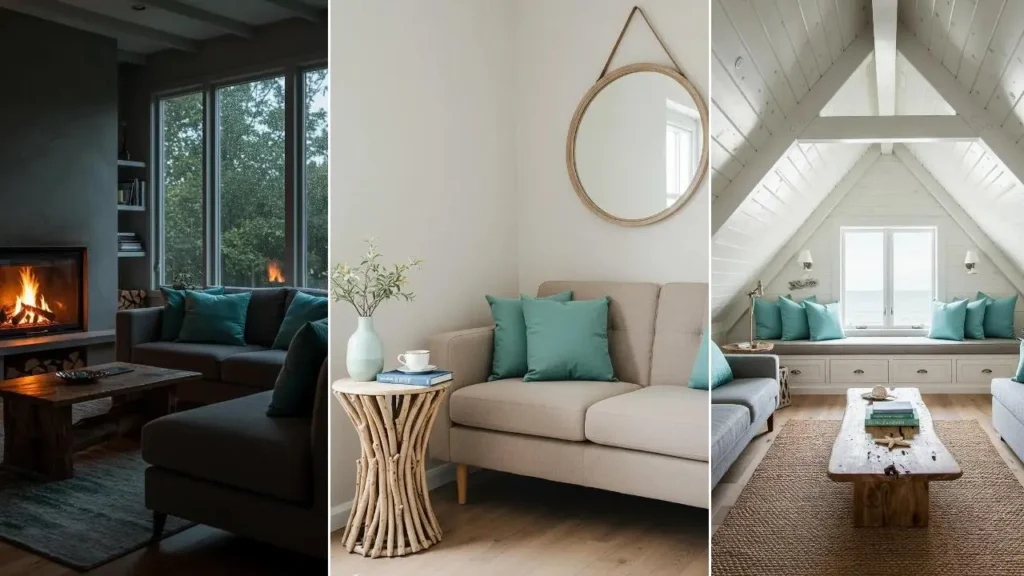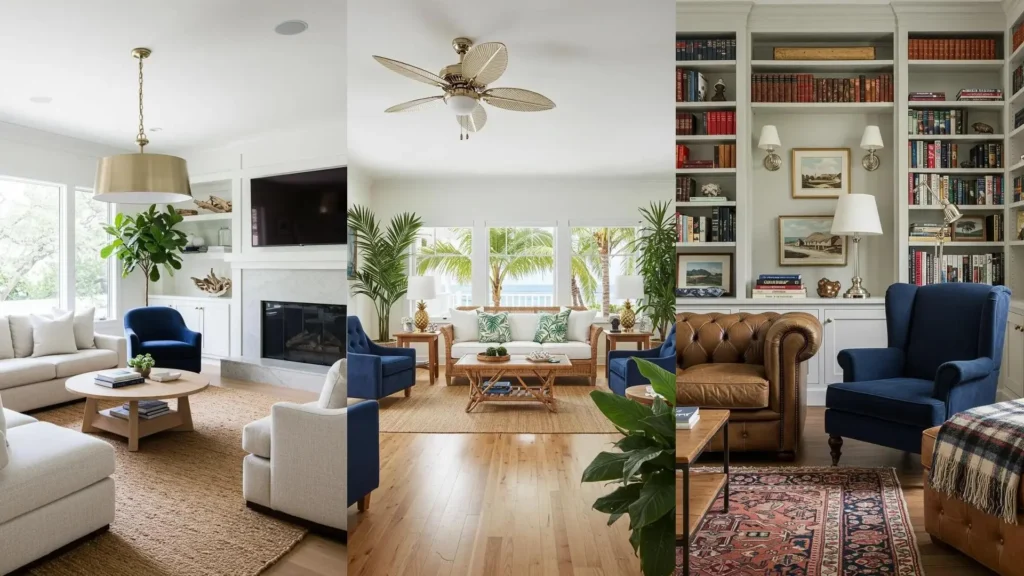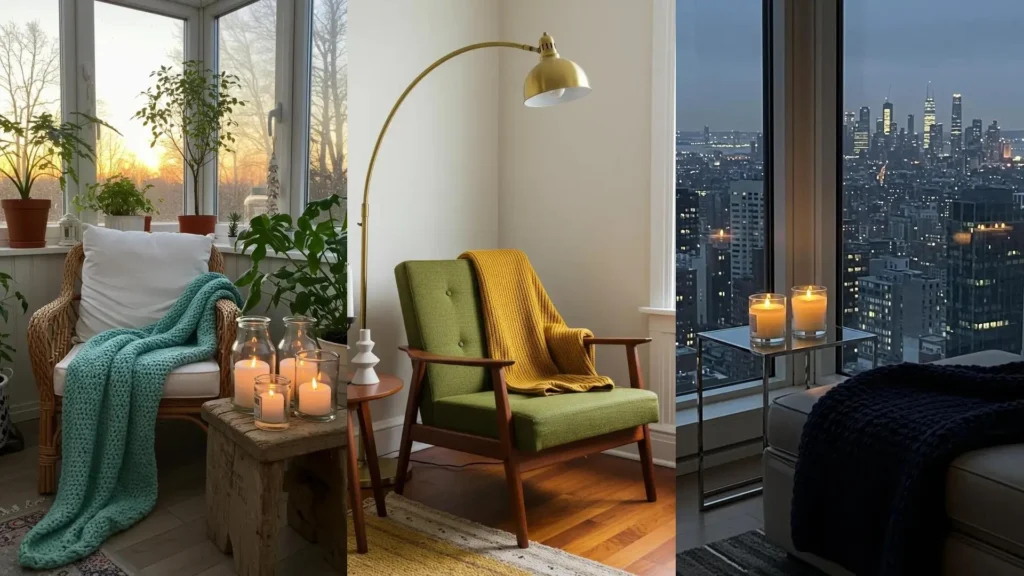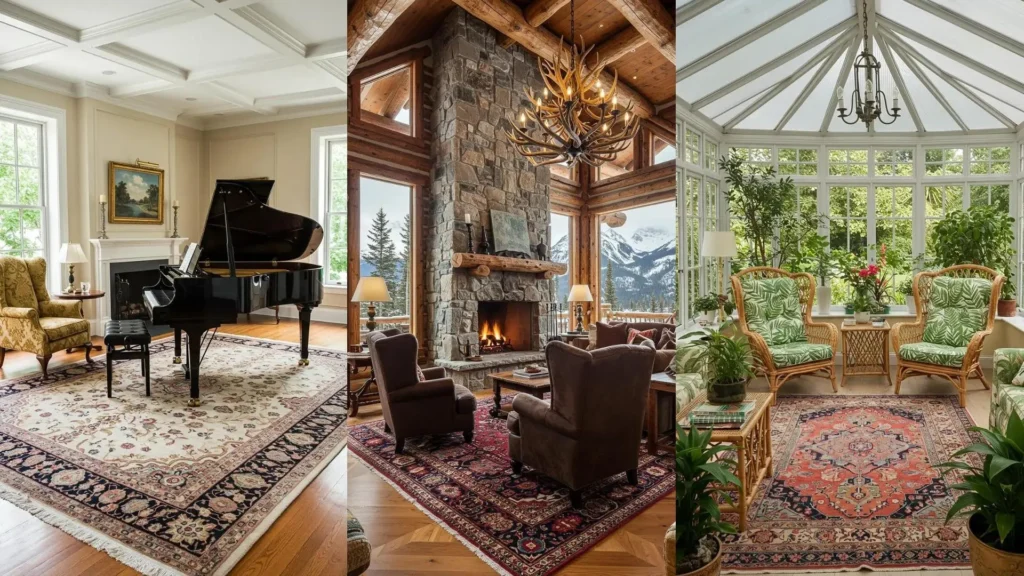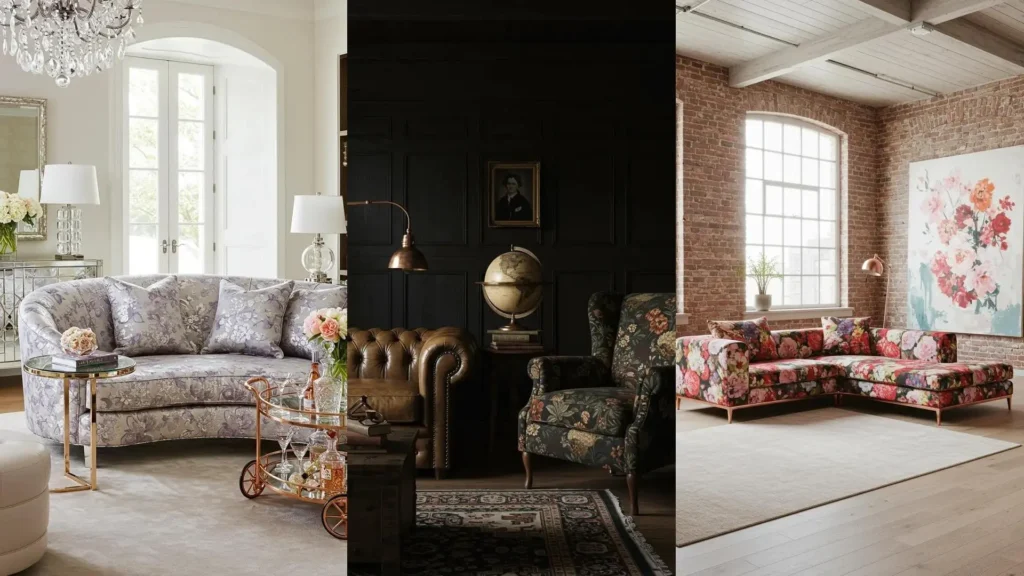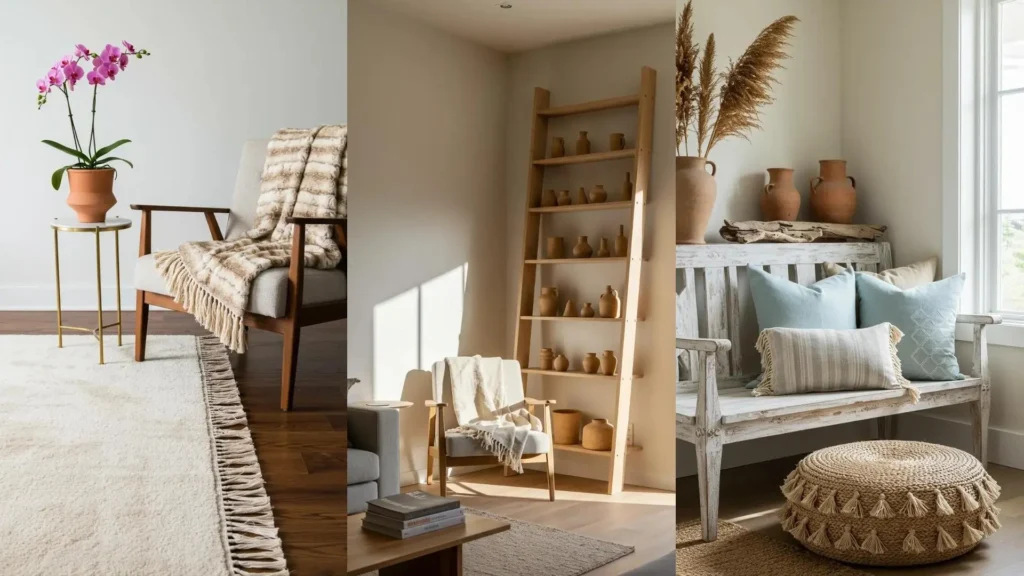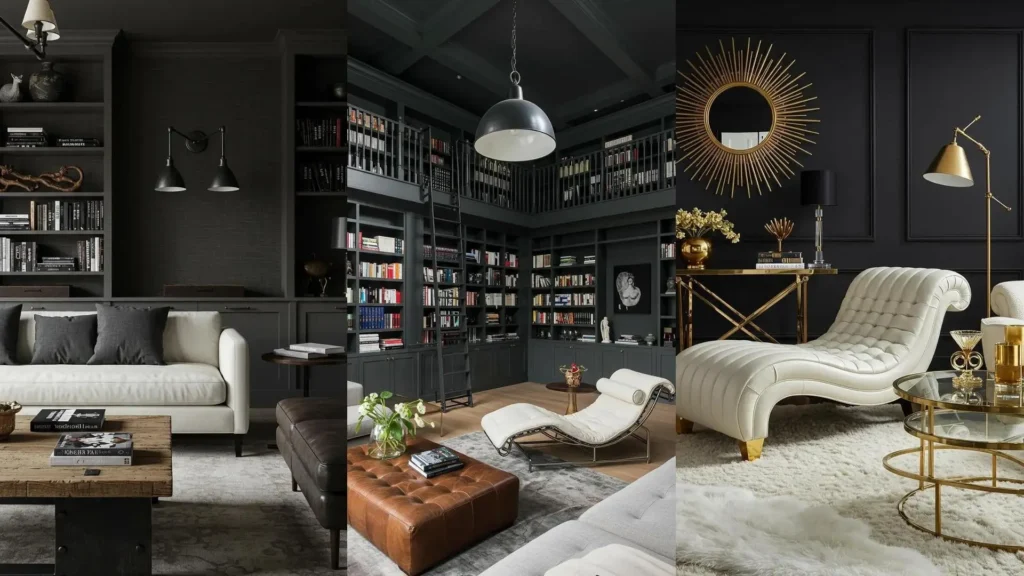That feeling of calm you’re searching for in your home isn’t about starting over from scratch.
It’s found in small, intentional shifts—the kind that quietly transform a room from a collection of things into a space that feels like an extension of you.
Coastal minimalism isn’t a theme; it’s an exhale. It’s the balance of raw, weathered wood against the softness of sea-glass aqua, the simplicity of a sun-bleached palette, and the clean lines that give your mind space to rest.
Here, we’ll move beyond inspiration and into action. These aren’t just rooms to admire; they are roadmaps you can follow, one thoughtful detail at a time.
1. The Sculptural Anchor
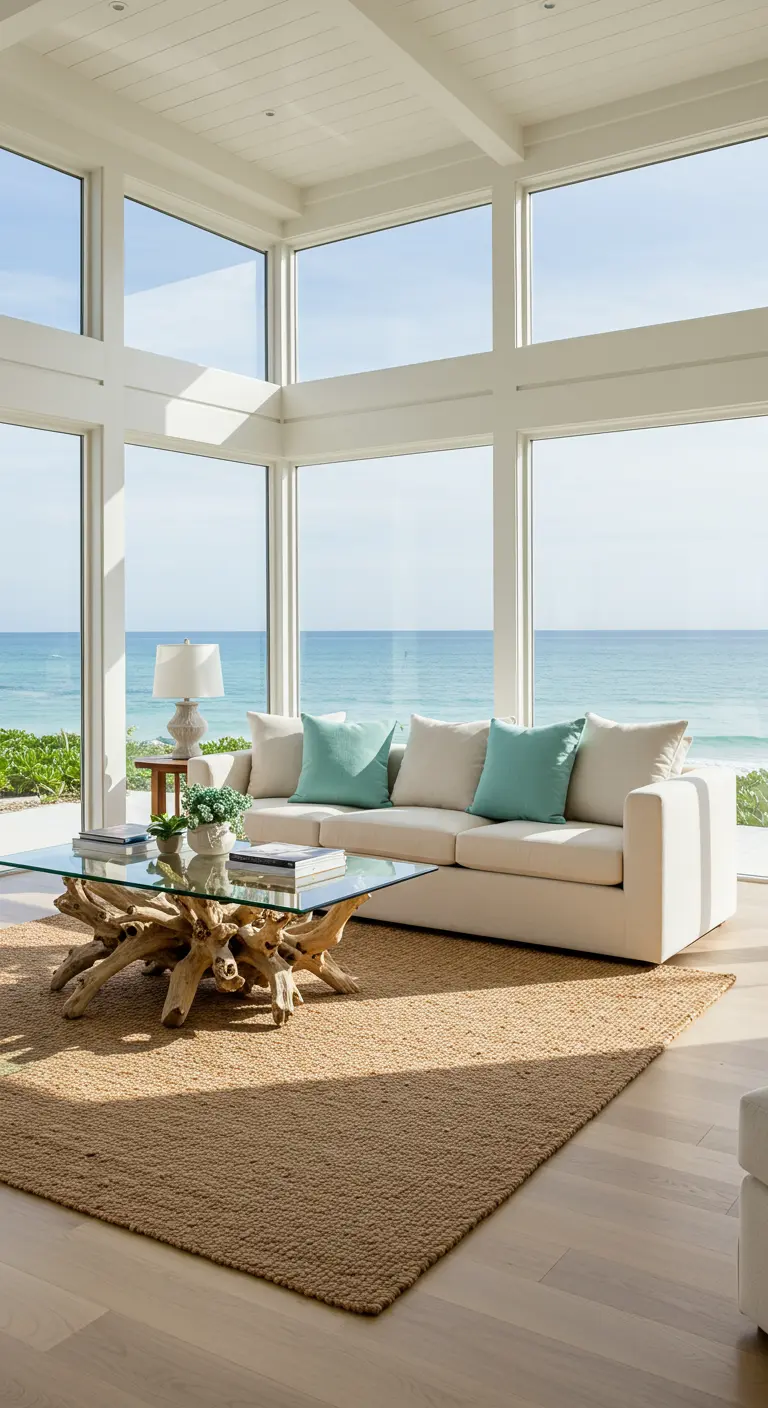
When you choose a coffee table with this much natural artistry, treat it as the room’s sculpture.
Notice how the glass top is essential here; it allows you to appreciate the intricate driftwood base from every angle without visually overpowering the space.
Ground this statement piece with a simple, textural rug like jute or sisal. It adds warmth and defines the seating area without competing for attention.
2. Soften an Industrial Edge
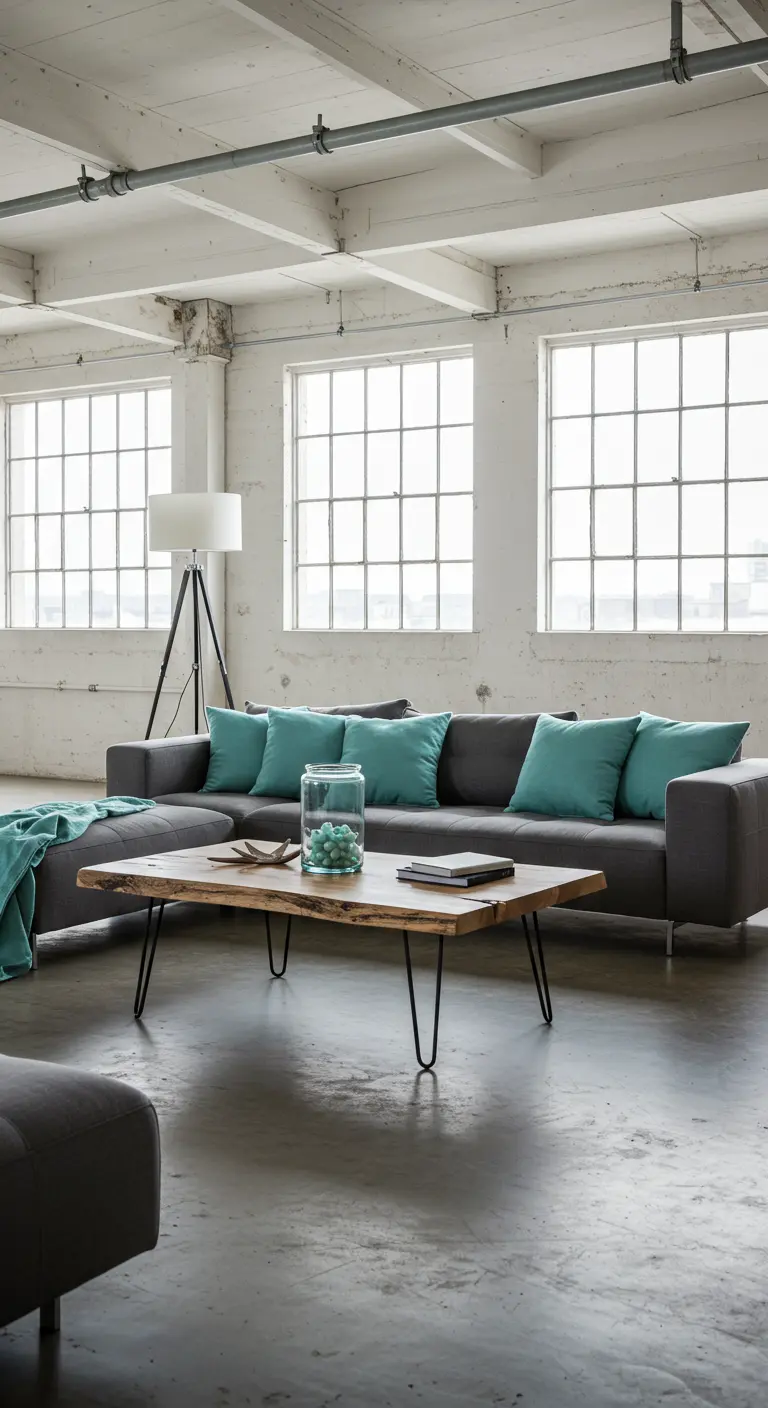
If your space has strong industrial elements like concrete floors and exposed pipes, the key to making it feel like a home is contrast.
Introduce a deep, comfortable sofa and soften it immediately with pillows in a gentle, soothing color like this soft aqua.
A live-edge wood table on slender hairpin legs bridges the gap between raw and refined, adding organic warmth that balances the cool tones of the concrete.
3. The Power of the Pare-Down
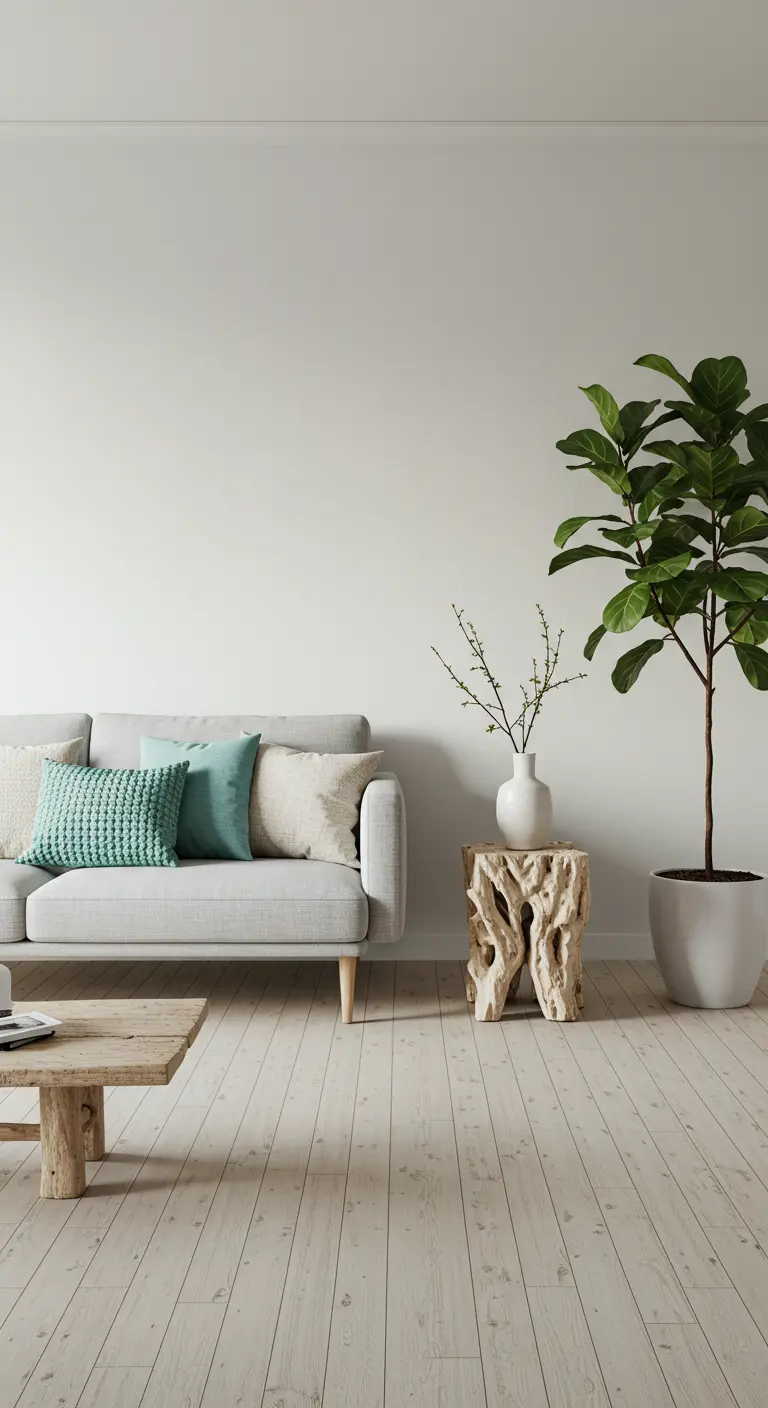
True minimalism isn’t about emptiness; it’s about giving each object significance.
In a corner, instead of adding more, try taking something away. Here, a simple driftwood stump serves as a sculptural side table—functional, yet artistic.
Paired with a streamlined sofa and a fiddle-leaf fig, the composition feels intentional and calm. It proves that thoughtful placement is more impactful than sheer volume. This approach is central to creating contemporary Zen homes.
4. Layer Textures for Lived-In Warmth
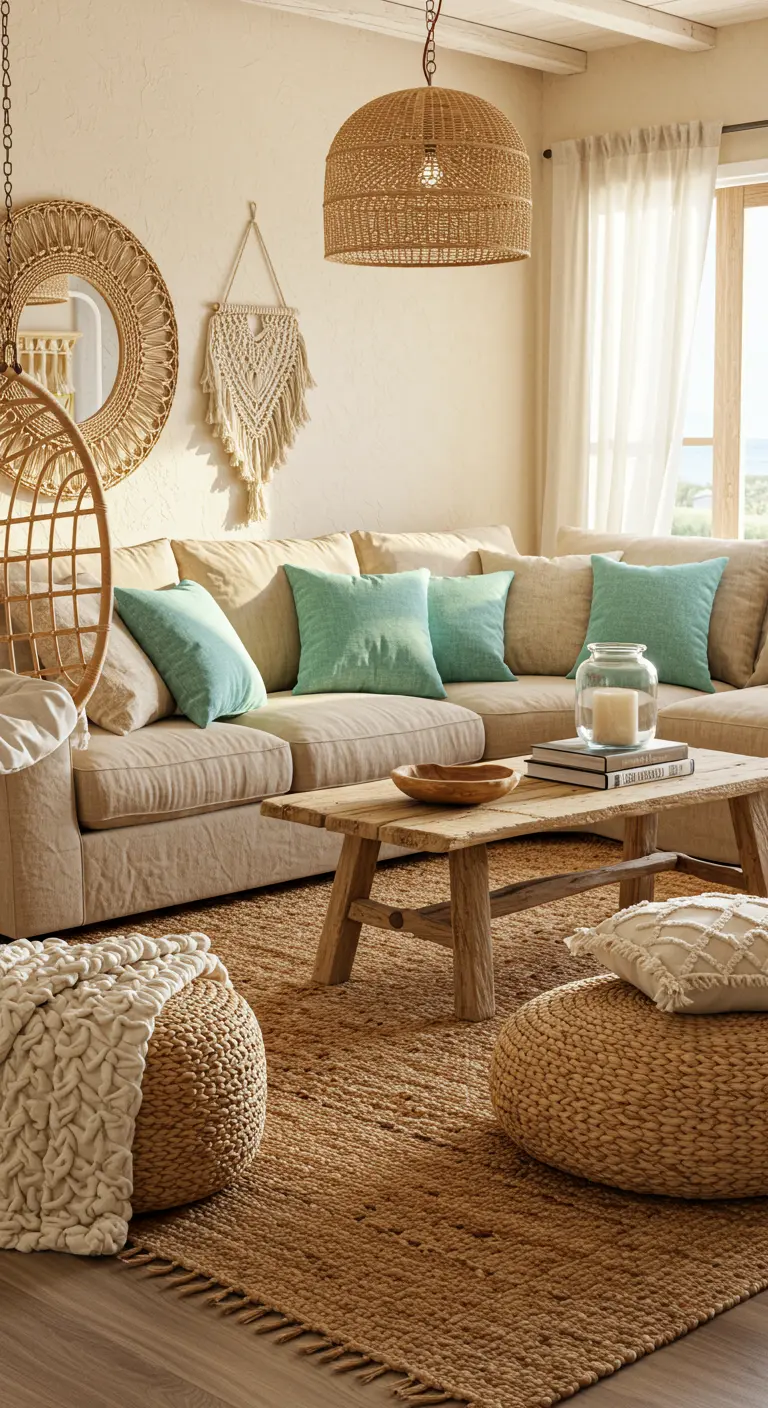
A cohesive room is often built on layered textures, not just colors.
Combine woven seagrass, chunky knit throws, smooth cotton, and rough-hewn wood. The shared palette of sandy neutrals prevents these varied surfaces from feeling chaotic.
The aqua pillows are your accent—they lift the earthy tones and add a touch of fresh, coastal air, preventing the design from feeling too monochromatic. These are key principles in many warm, earth-tone rooms.
5. Define a Corner with Purpose

Transform an overlooked corner into an intentional destination.
A small-scale loveseat, a sculptural side table, and a mirror are all you need to create a quiet reading nook.
Hang a round mirror to soften the sharp angles of the walls. Its circular shape introduces a gentle, organic form that contrasts beautifully with the room’s linear structure, making the space feel more dynamic. These cozy corners for small rentals show just how effective this strategy can be.
6. Let One Piece Command the Room
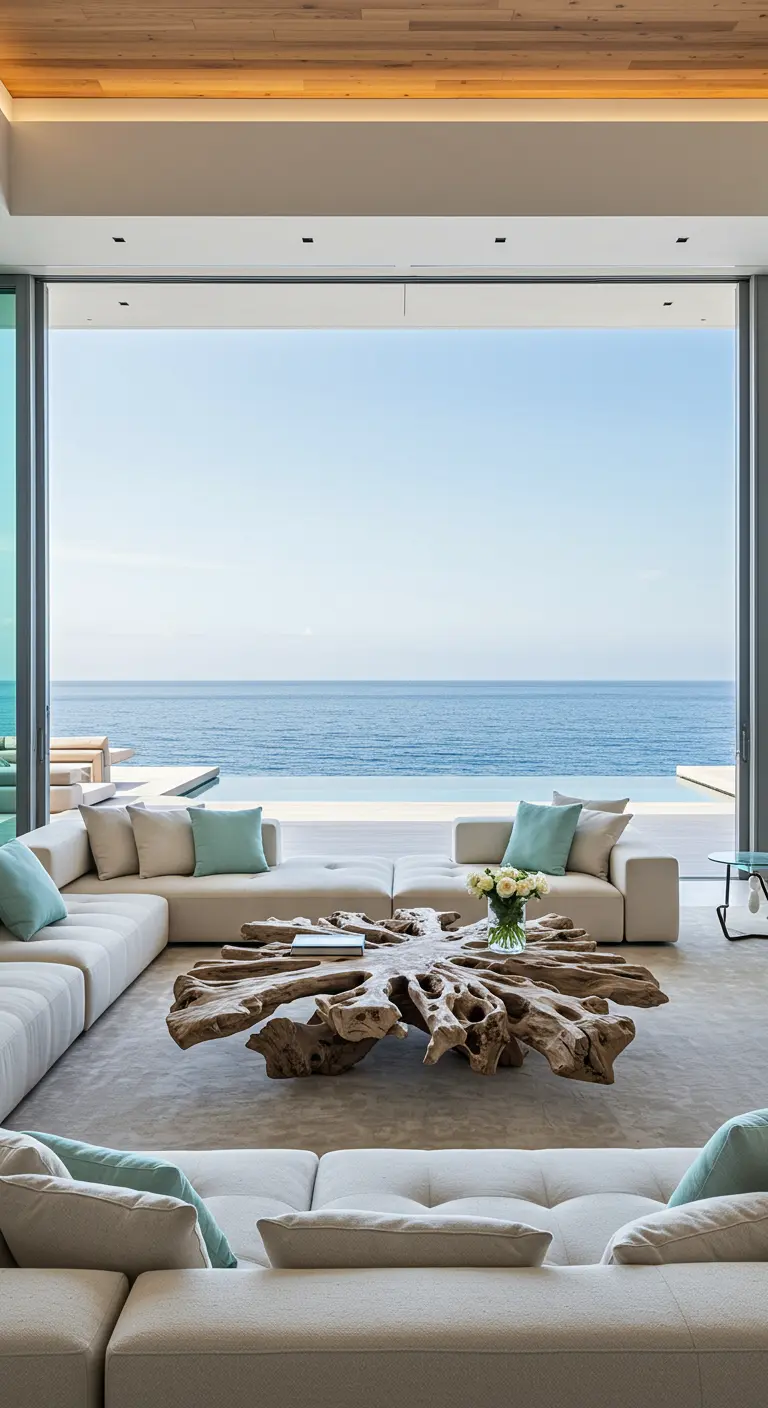
When you have a truly magnificent piece like this driftwood table, allow it to be the hero.
The rest of your furniture should play a supporting role. Notice how these low-profile, armless sofas are elegant and comfortable, yet they sit back and let the table hold the spotlight.
Keep the color palette minimal—creamy whites, soft aqua—to ensure nothing distracts from your centerpiece. The focus remains on the incredible natural form, which makes the entire room feel special.
7. The Understated Impact of Filtered Light
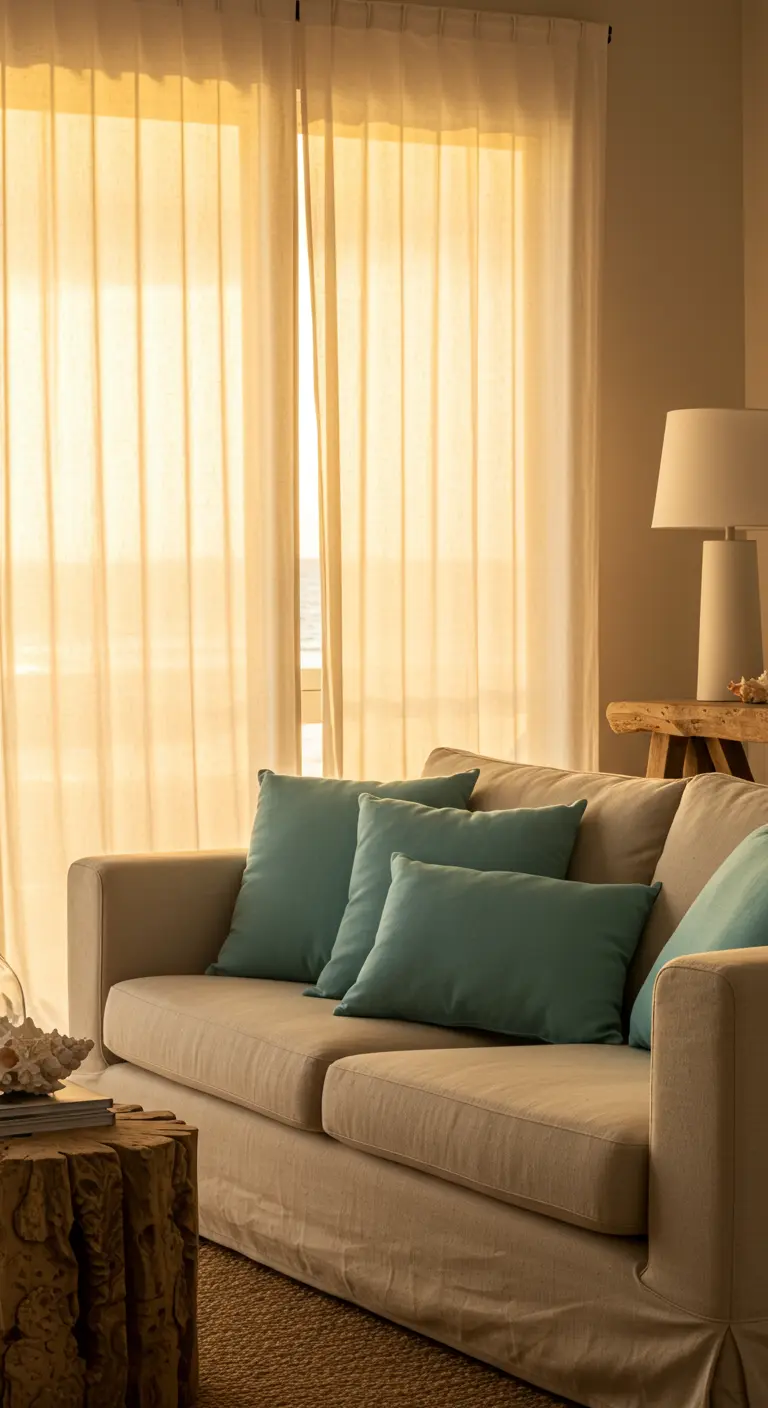
Your window treatments are as important as your furniture. To achieve this soft, ethereal glow, swap heavy, opaque drapes for sheer linen or cotton panels.
They don’t block the light; they filter it, casting a warm, gentle ambiance across the room while still providing a sense of privacy.
This simple change instantly makes a room feel lighter, airier, and more connected to the time of day, enhancing the calm atmosphere you want to create.
8. Walls That Whisper, Not Shout

Instead of a flat paint color, consider a textured wall finish like limewash or a Roman clay plaster.
The subtle variations in tone and texture add immense depth and movement, creating a backdrop that feels organic and alive.
This tactile surface beautifully complements the raw, weathered nature of a driftwood coffee table, making the entire space feel grounded and sophisticated.
9. Ground Your Palette with a Classic Stripe
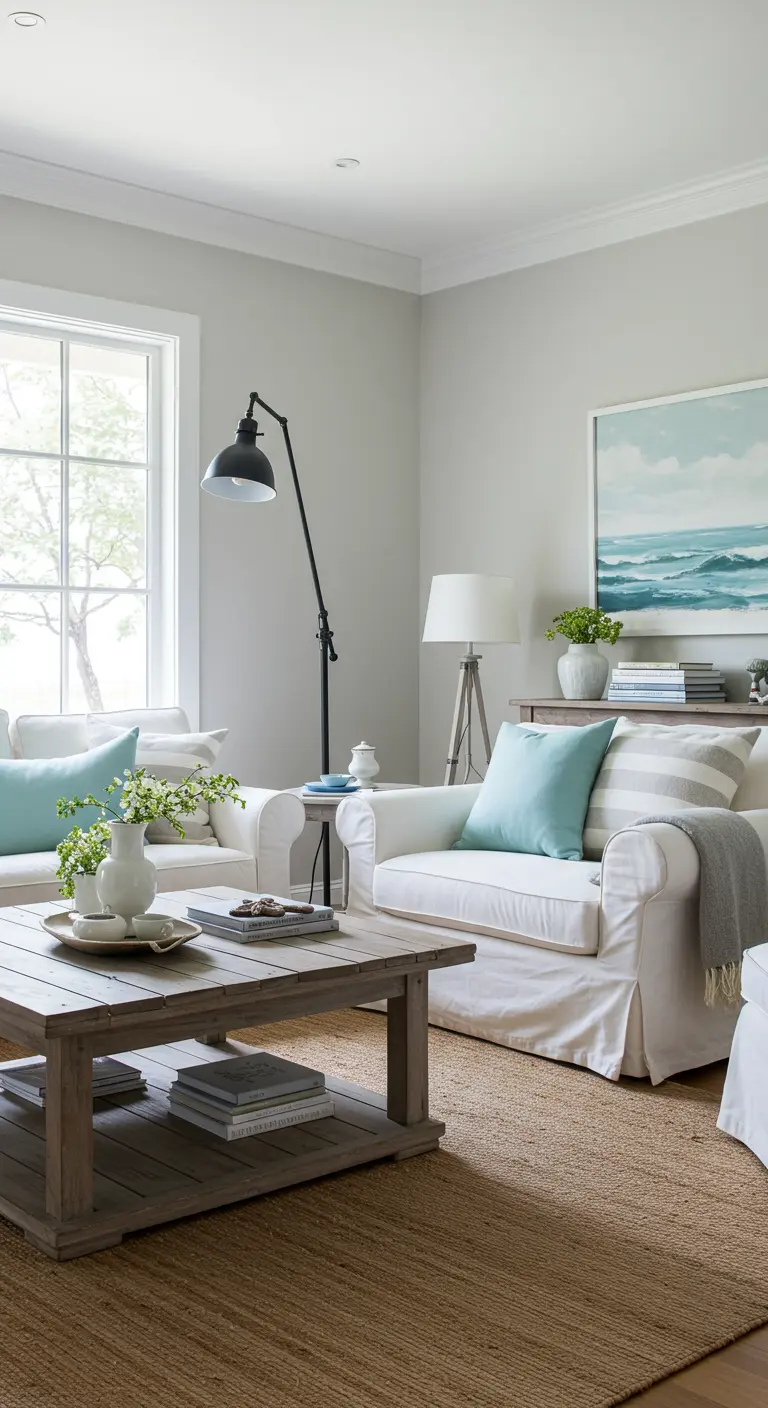
If you’re hesitant to mix patterns, a simple stripe is the perfect place to start. It’s timeless, orderly, and adds visual interest without creating chaos.
Here, a single striped pillow layered with solid aqua and white ones adds just enough detail to break up the solids.
This classic touch nods to nautical style in a sophisticated way, making these coastal-inspired spaces feel curated and complete.
10. Create Structure with Bold Contrast
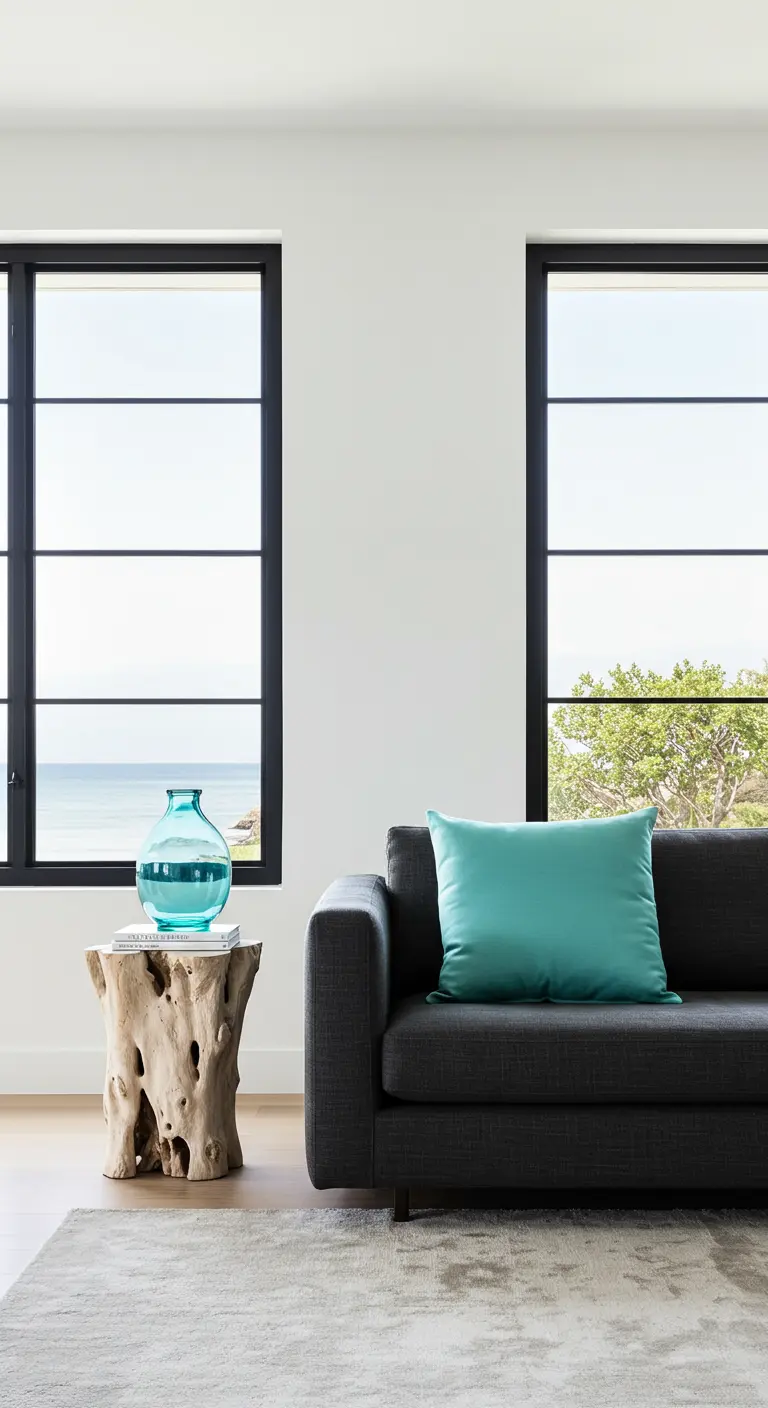
The black window frames in this room act as a powerful architectural statement, like art in themselves.
When you have such a strong graphic element, your decor can be more restrained. A single pop of saturated aqua on the pillow is all that’s needed to provide a focal point.
Paired with the organic sculpture of the driftwood side table, the result is a balanced composition of sharp lines and soft forms. Using bold color blocking and contrast creates definition.
11. Blur the Line Between Indoors and Out
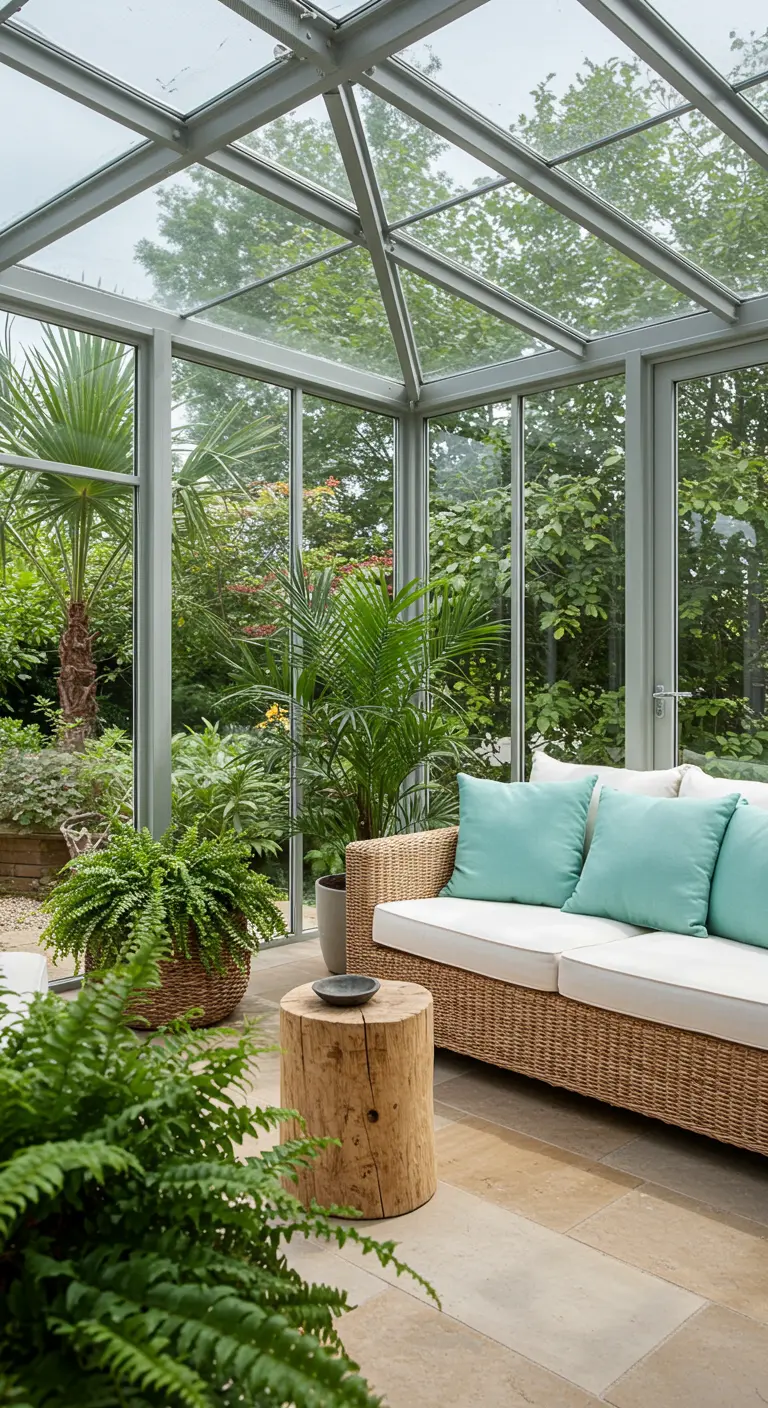
When a room opens directly to a garden, use materials that echo the outdoors to create a seamless transition.
A wicker sofa, a simple wood stump table, and stone-colored flooring all feel like they could belong inside or out.
Fill the space with lush greenery. By surrounding yourself with plants, you blur the architectural boundaries and make the room feel like a natural extension of the garden itself. You can achieve this sophisticated garden vibe even in smaller spaces.
12. Emphasize Architectural Character
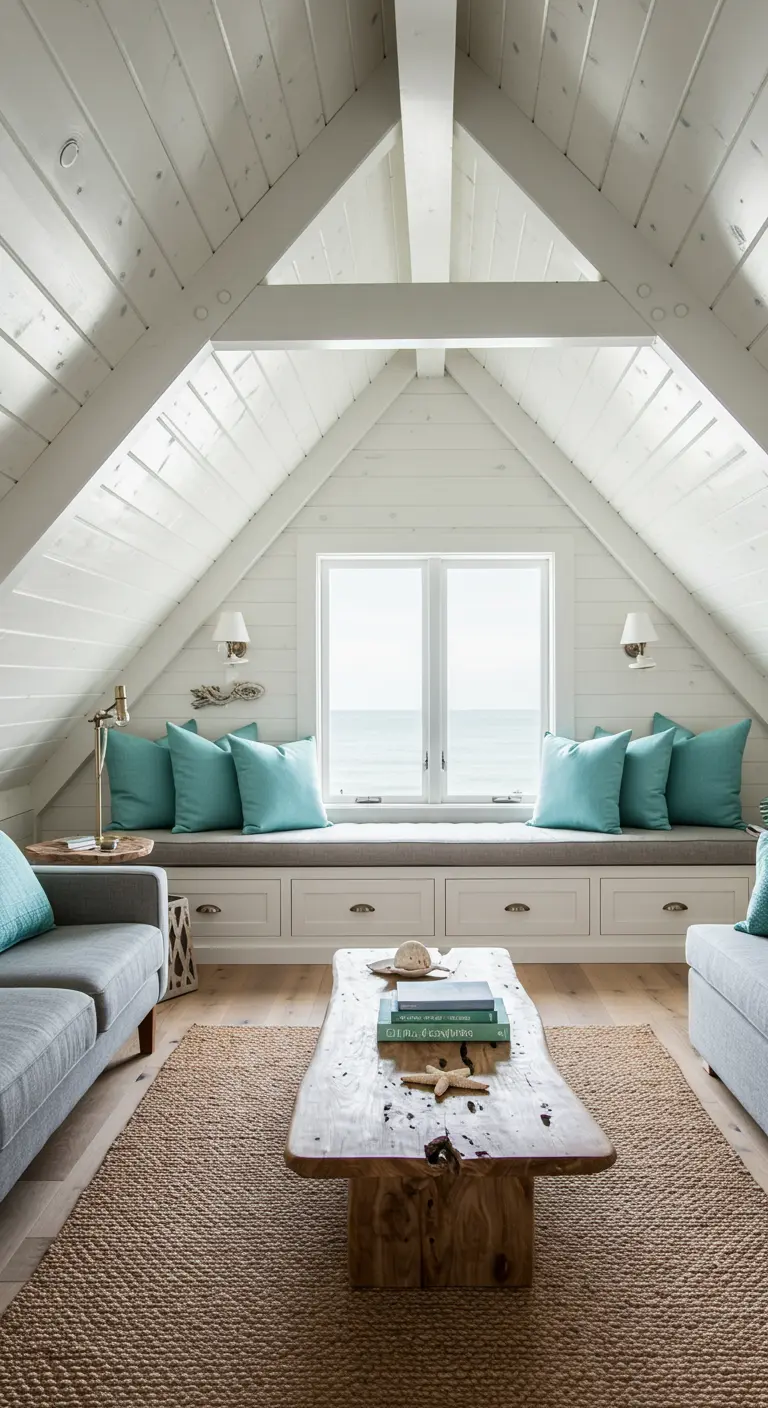
If you have a room with beautiful bones, like this vaulted shiplap ceiling, make it the star.
Paint the walls and ceiling a clean, uniform white to draw the eye upward and accentuate the height and lines.
A built-in window seat is a brilliant addition—it provides ample seating and hidden storage, making the room both beautiful and incredibly functional. The right furniture layout makes the most of any room’s unique shape.
13. Trade Weathered Wood for Polished Concrete
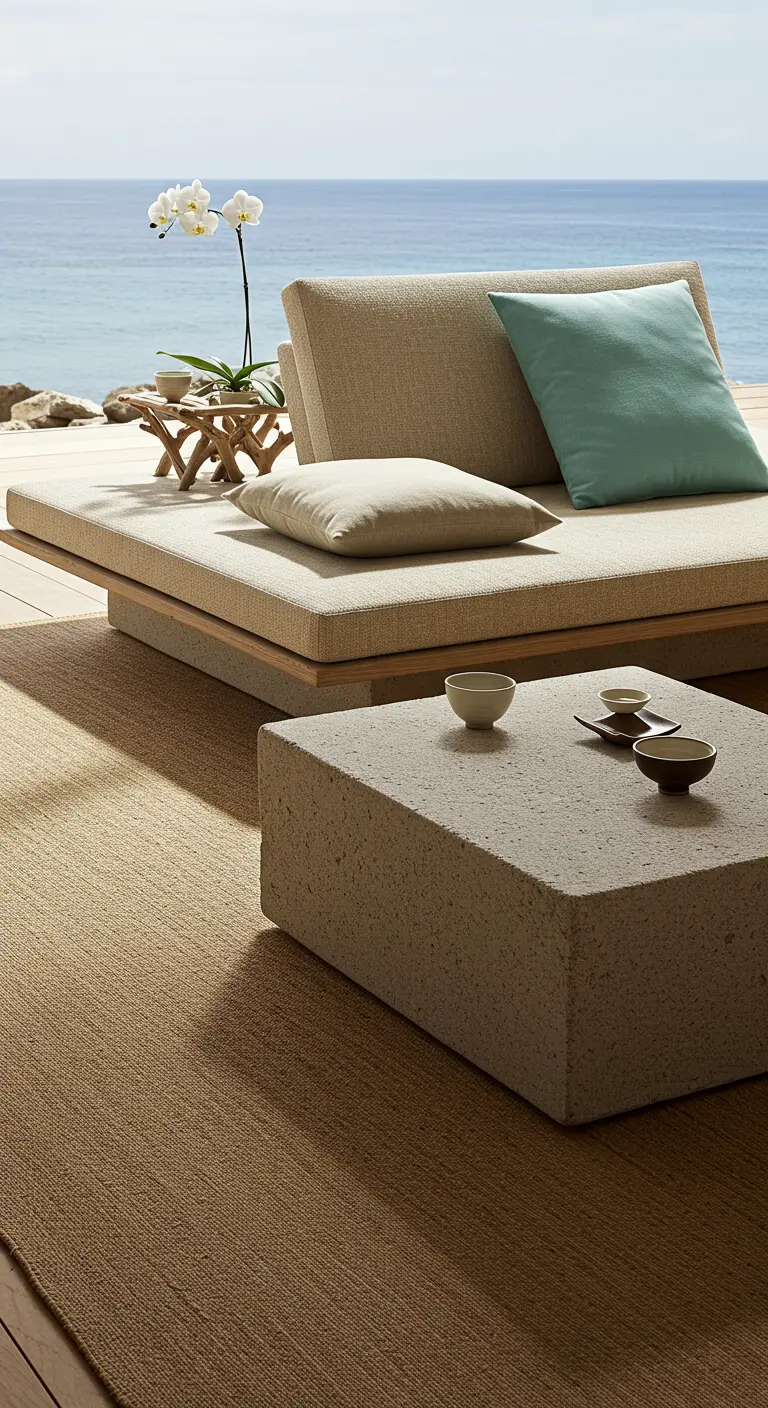
For a more modern interpretation of the coastal aesthetic, consider swapping a wood coffee table for one made of concrete or terrazzo.
Its cool, smooth surface and monolithic form provide a sophisticated contrast to the softness of the surrounding textiles.
This unexpected material choice feels clean, durable, and decidedly contemporary while still maintaining a connection to natural elements. It’s a key feature in many desert oasis-inspired designs.
14. Let Art Dictate Your Accent Colors
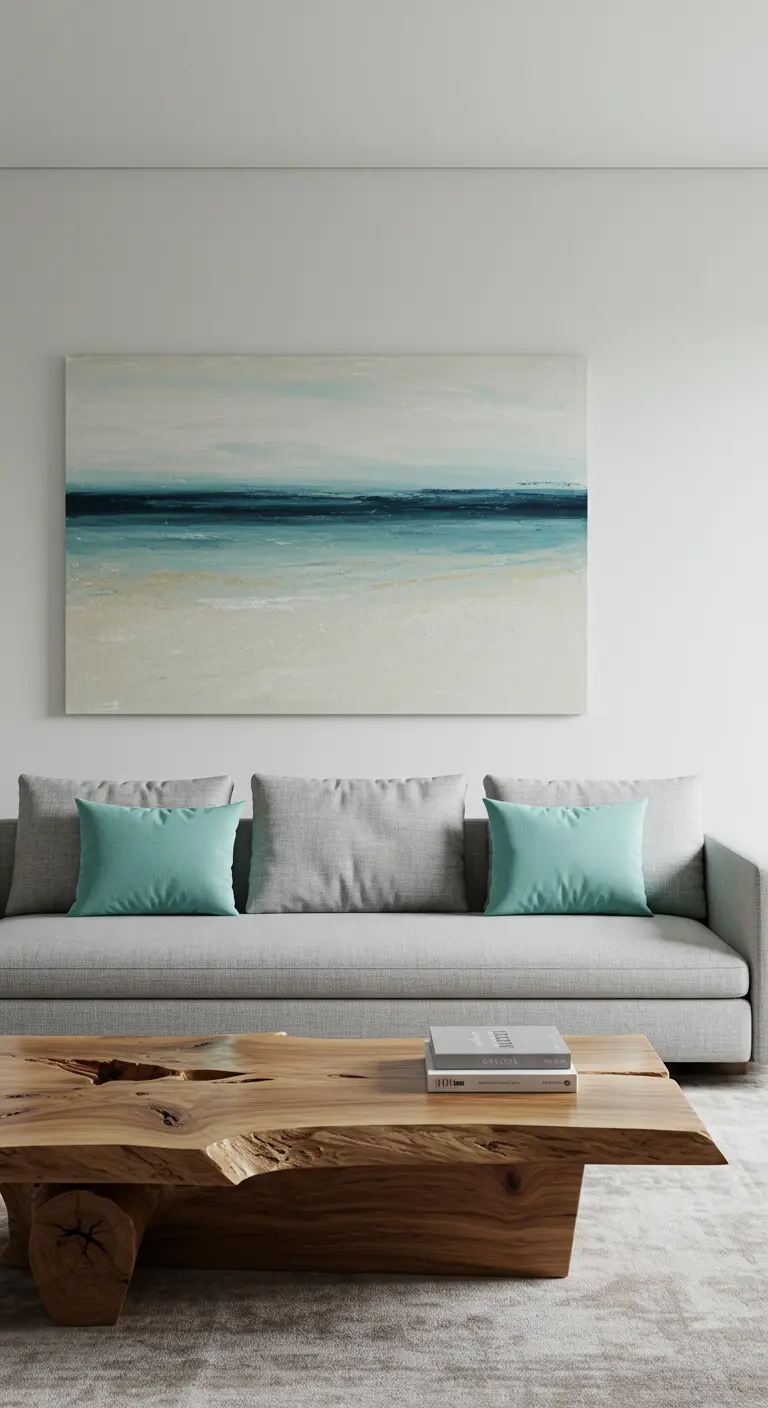
Struggling to choose your accent colors? Look to your art.
Pull the softest aqua and the palest grey directly from this abstract seascape and repeat them in your throw pillows. This simple technique is the secret to a professionally curated look.
It creates an instant, harmonious connection between your walls and your furniture, making the entire room feel cohesive and intentional.
15. Marry Beauty with Functional Storage
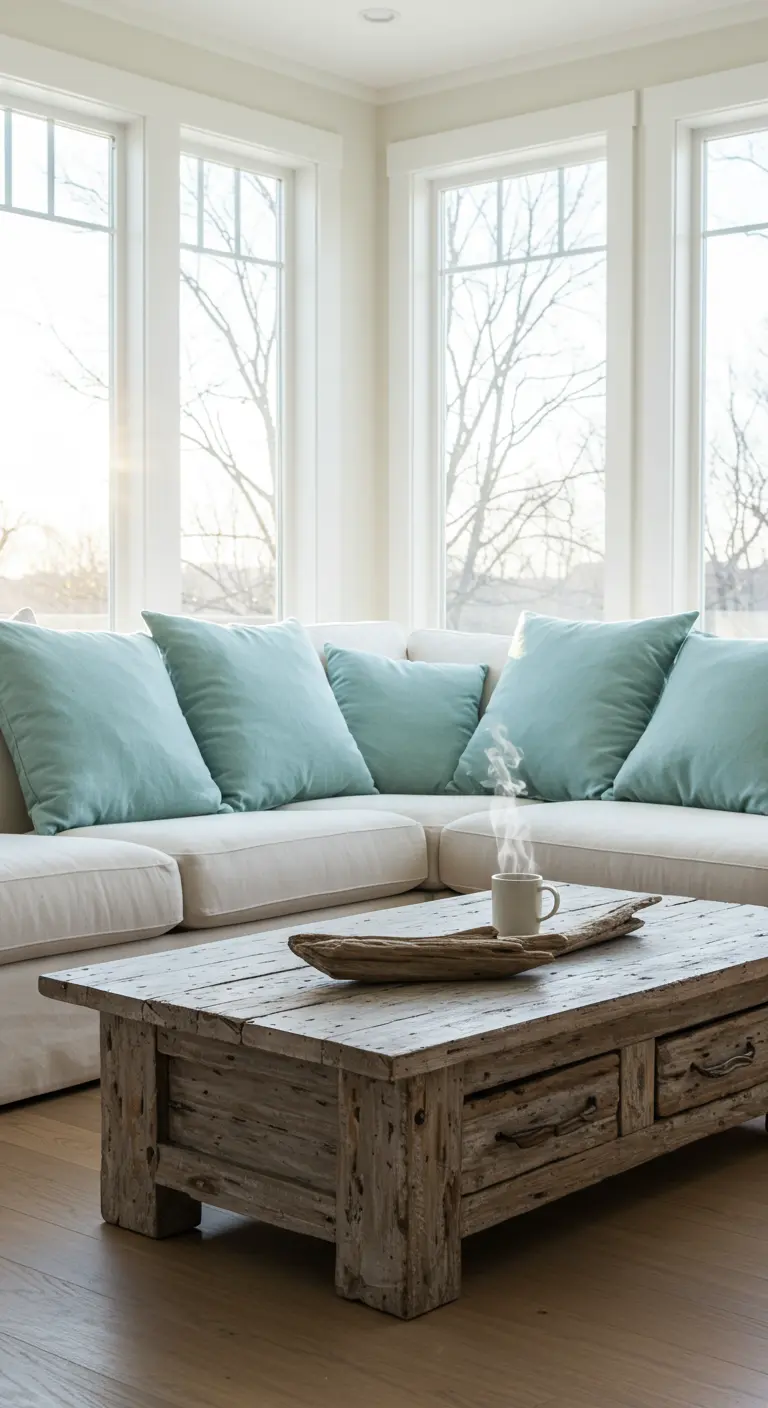
A serene space is a tidy space. Choose a coffee table that works hard without showing it.
This rustic table offers the beauty of reclaimed wood but also includes deep drawers—the perfect place to tuck away remotes, coasters, and magazines.
Opting for furniture with integrated storage is the single most effective way to maintain a calm, minimalist aesthetic in a room you actually live in. Hidden storage is a form of everyday elegance.
16. Focus on Rich, Tactile Textures
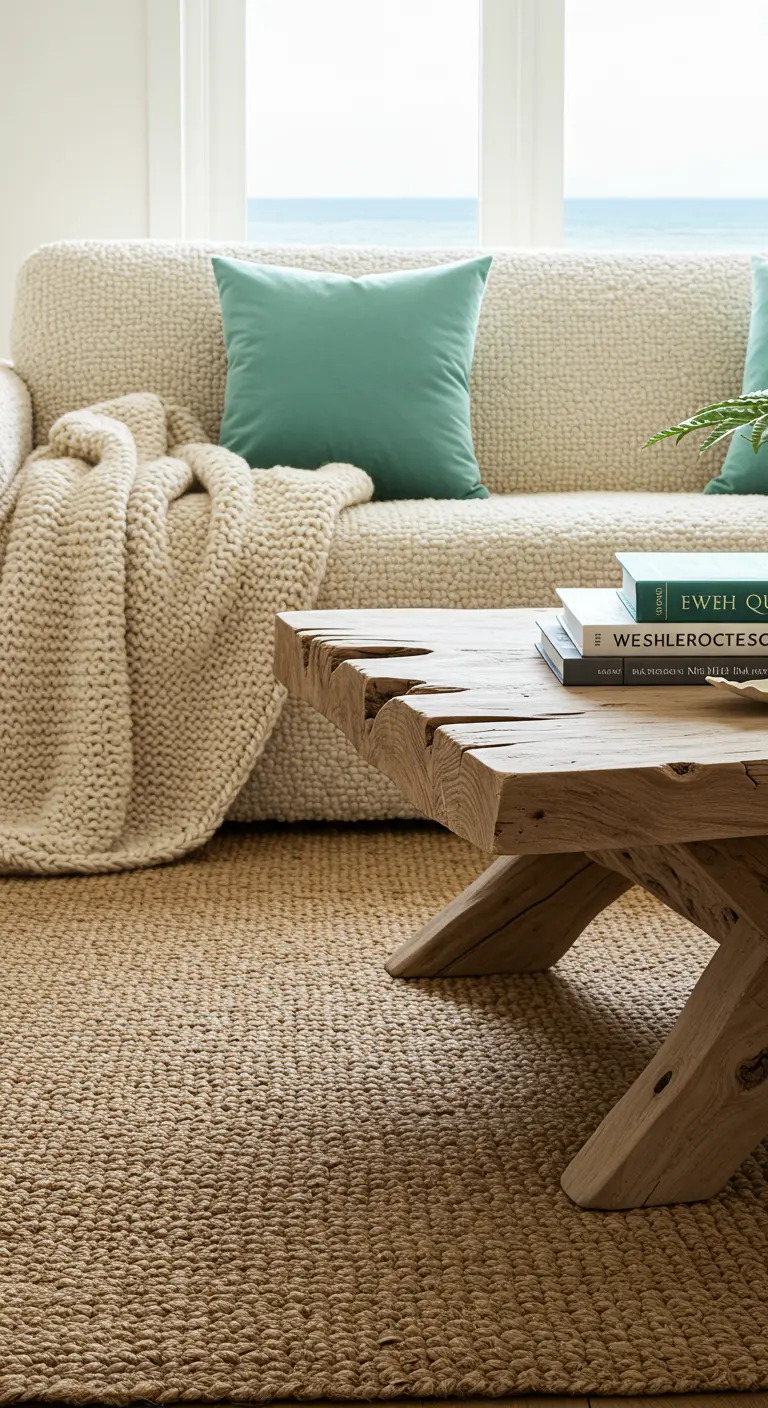
A neutral room comes alive through touch. Invite people to experience the space by layering a variety of textures.
Here, the nubby feel of a bouclé sofa, the coarse weave of a jute rug, and the soft weight of a chunky knit throw create a rich sensory experience.
The contrast between these surfaces is what gives the room its depth and warmth, a core tenet of Scandinavian hygge design.
17. Create Architecture with Arched Niches
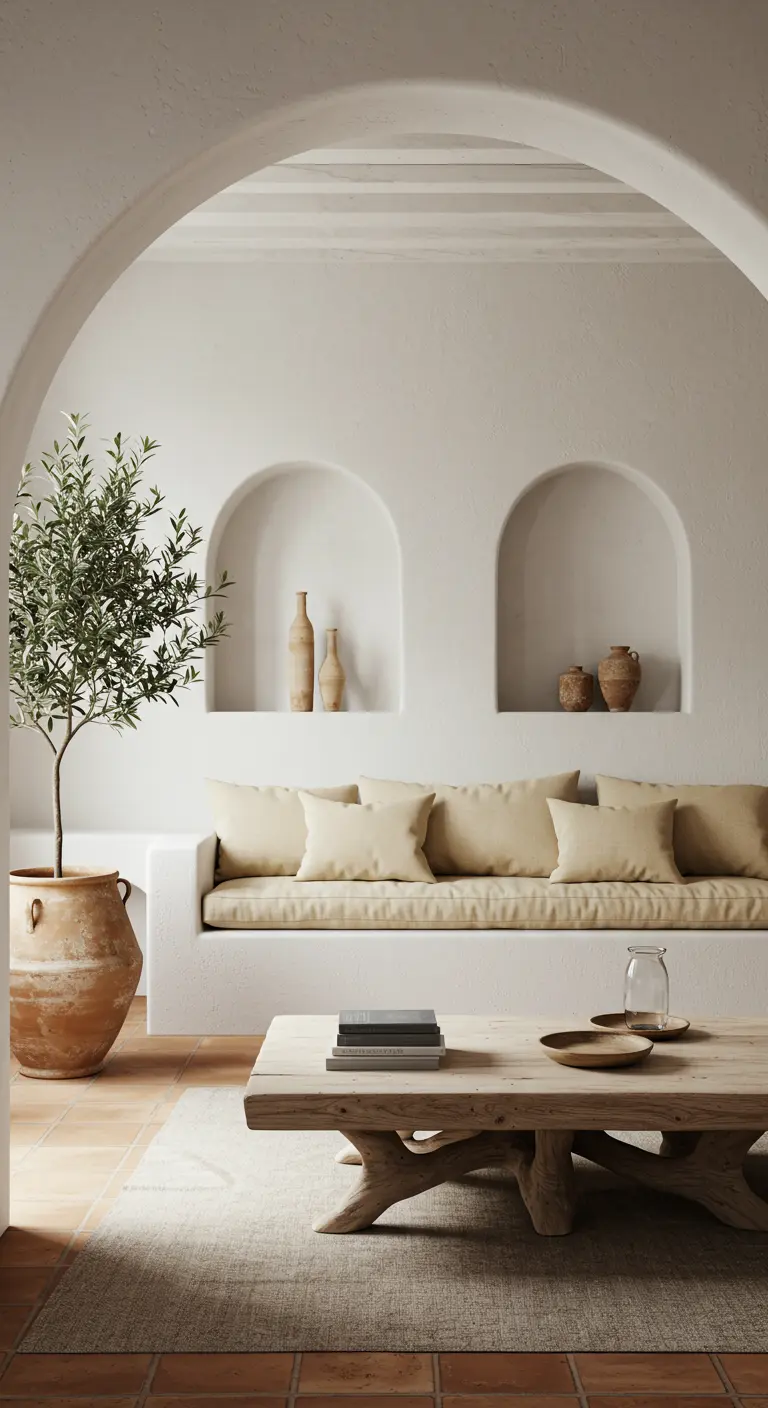
If you have a long, plain wall, consider adding shallow, arched niches. This is a powerful way to create architectural interest where there was none.
They provide the perfect, protected space to display a few treasured objects—a piece of pottery, a sculptural branch—turning simple storage into a curated statement.
This touch of Mediterranean-inspired design adds a sense of history and soulful calm to a modern room.
18. The Calming Power of Symmetry
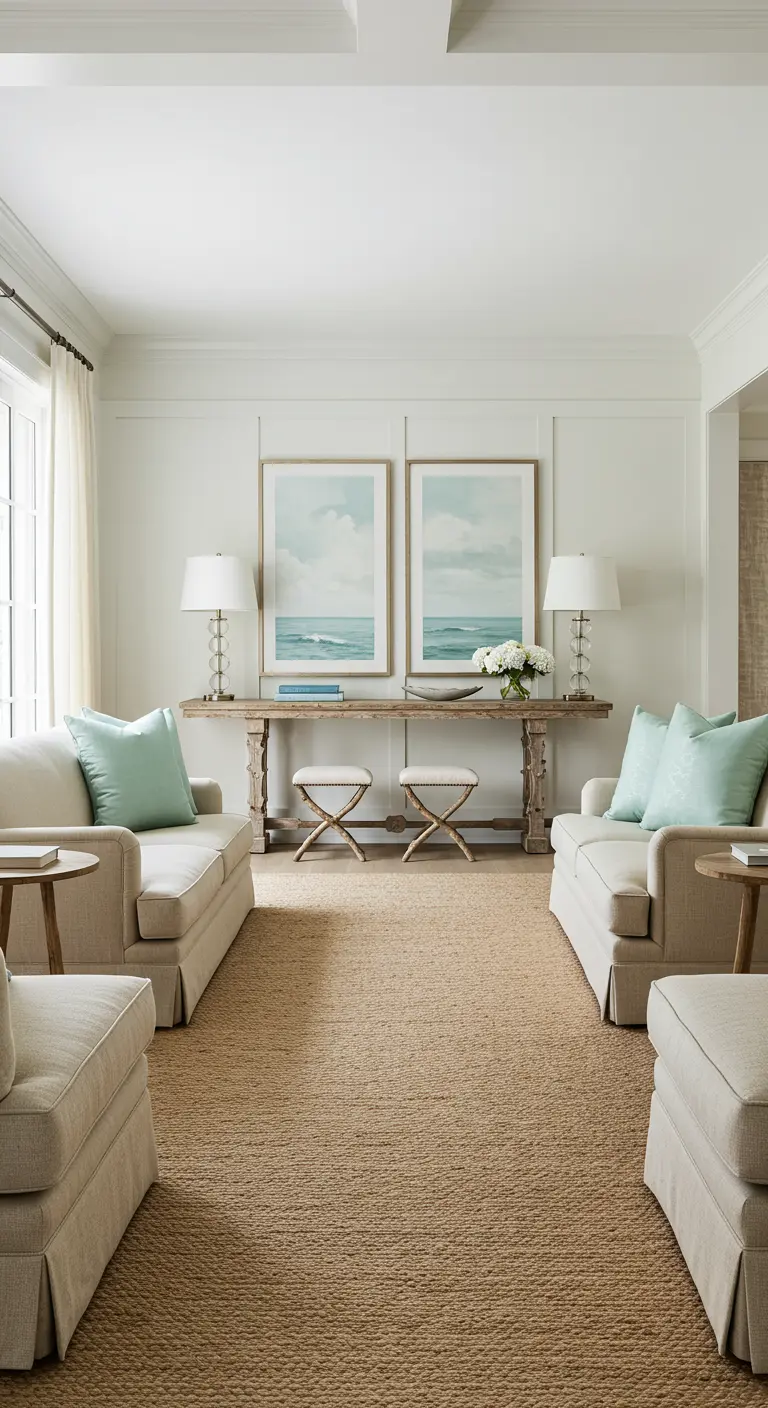
For an immediate sense of harmony and order, arrange your main seating symmetrically.
Placing two identical sofas directly facing each other creates a naturally balanced and conversational layout. It feels calm, formal, and intentional.
Anchor the arrangement with a long console table behind one sofa, topped with matching lamps. This reinforces the symmetry and provides soft, layered lighting. The same principle brings elegance to a garden arch entrance.
19. A Coastal Mood for All Seasons
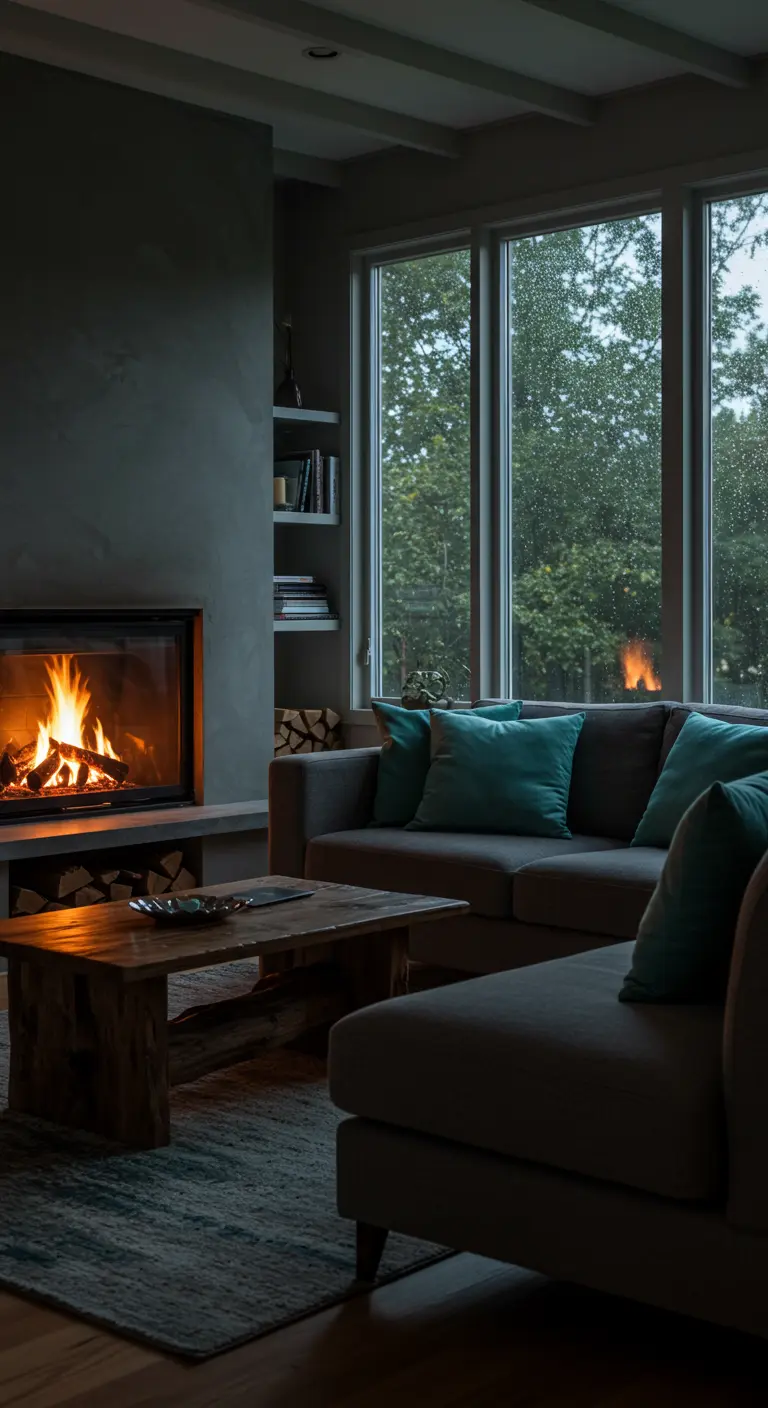
Coastal design doesn’t have to be exclusively bright and summery. You can evoke the feeling of a dramatic, windswept shoreline, too.
Pair a dark charcoal sofa with deeper, moodier shades of aqua and teal. A fireplace and warm wood tones provide a comforting glow, creating a perfect retreat for a rainy day.
This palette feels sophisticated and cozy, much like you’d find in these Scandinavian winter retreats.
20. Unify an Open-Concept Layout
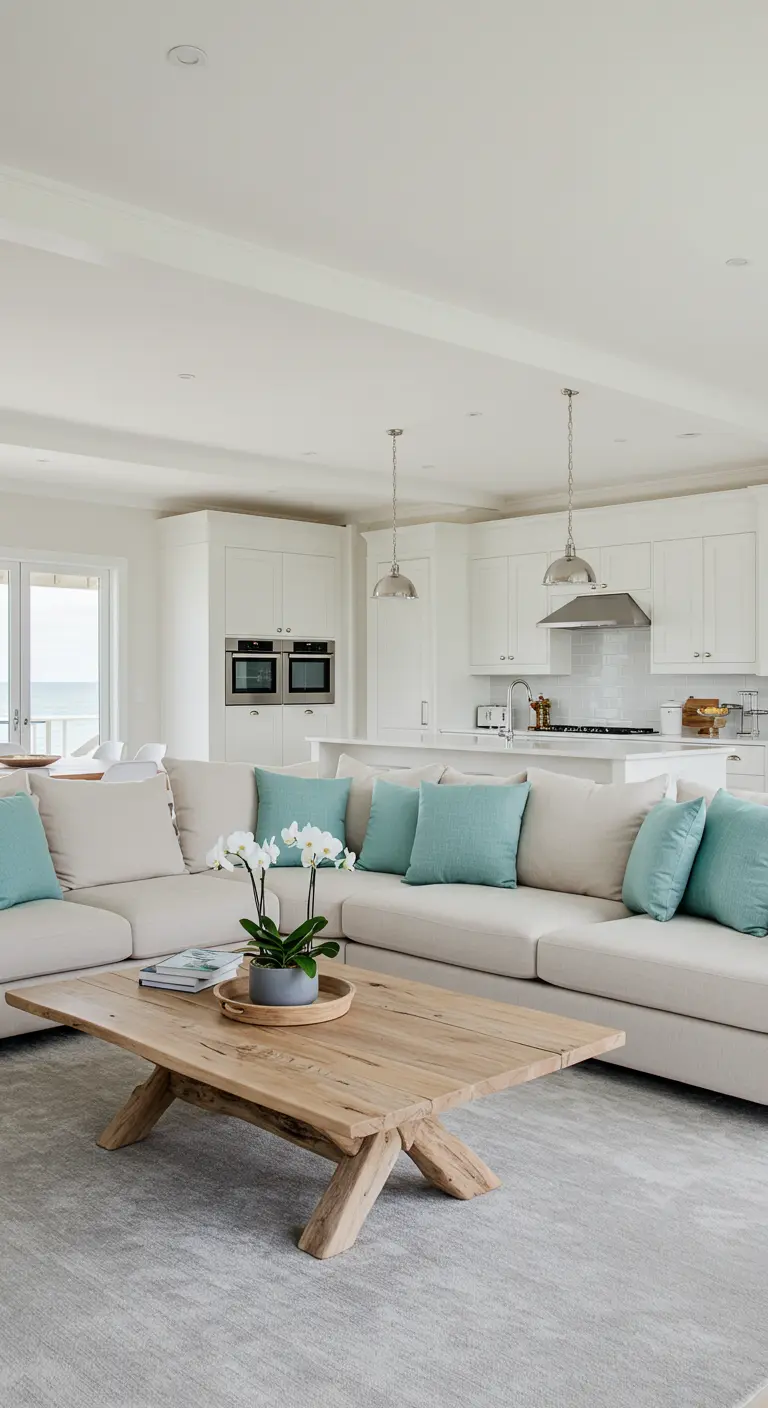
In an open-plan home, create a sense of cohesion by repeating your accent color across different zones.
The soft aqua of the throw pillows on the sofa is a visual cue that connects the living area to the kitchen space.
You could echo this color in a fruit bowl, a set of glasses, or even the backsplash tile. This simple repetition creates a visual thread that ties the entire floor together. This trick works even in boldly different styles like modern gothic kitchens.
21. Introduce an Unexpected Metallic Finish

Elevate your coastal palette by introducing an unexpected material. A hammered or cast metal coffee table adds a touch of cool, modern glamour.
Its reflective surface catches the light beautifully, especially in a dimly lit room, providing a striking contrast to the soft, matte textures of the sofa and rug.
This small moment of surprise is what makes a design feel personal and thoughtfully layered, much like adding gold accents to a bathroom.
22. Let Natural Light Guide Your Layout
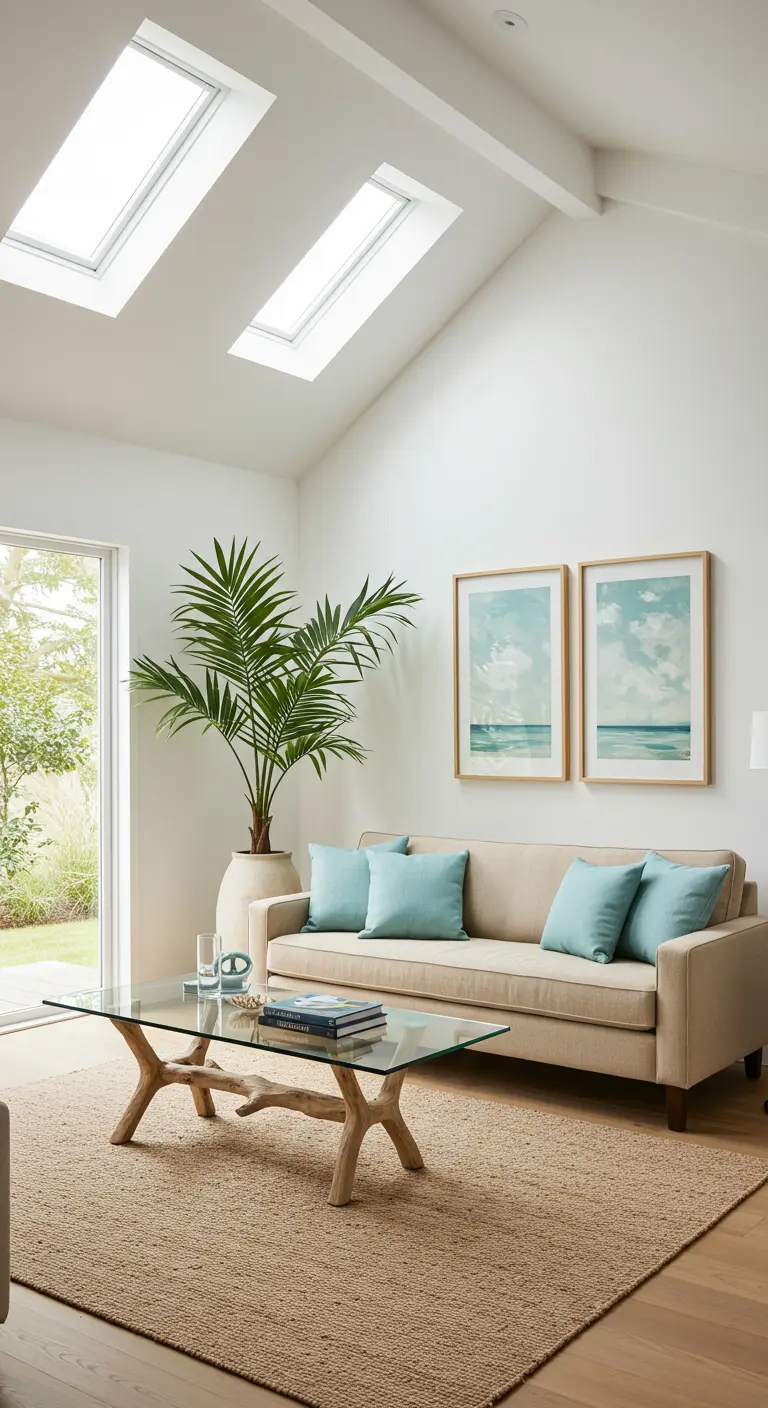
When you’re blessed with abundant natural light from skylights or large windows, design the room to celebrate it.
Keep the ceiling and walls a crisp white to reflect light around the space. Choose a glass-topped coffee table that won’t create a visual barrier, allowing light to flow through it to the floor.
A large palm or ficus adds a touch of life and draws the eye upwards, connecting the room to the sky above. You can create a similar light-filled oasis on a small balcony garden.
